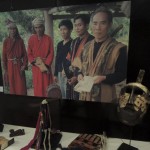By Kelly Macnamara (AFP)
YANGON — With a flamboyant wardrobe and a diva’s voice, she’s seen as Myanmar’s Lady Gaga — a rare pop star in a country where years of isolation have left musicians reliant on borrowed foreign tunes.
Singing Burmese translations of international hits like Bon Jovi’s “You Give Love A Bad Name”, Phyu Phyu Kyaw Thein is famed for her feathered masquerade masks, rhinestone glamour and dramatic ball gowns.
But she shrugs off the Lady Gaga comparison, saying she was shocking fans with her outfits in an eight-year career well before the US star made it big: “No offence, but it’s the truth.”
And unlike the eccentric American songstress her costumes do not reveal much leg or cleavage, in keeping with local customs.
The Myanmar pop singer, who grew up idolising far away megastars, describes decades of political isolation as like being “locked up in a cold, dark cave… some people around the world even didn’t notice we exist.”
The 30-year-old graduated with a medical degree but says she gave up training to become a doctor because people kept recognising her in hospital after her television performances.
“Still I am happy because I can make a change in the lives of millions of people around my country. I could make them happy,” she told AFP at her home in Yangon.
Myanmar pop is dominated by copies of international tunes, from the power ballads of Celine Dion to the soft rock strains of Rod Stewart, accompanied by sometimes incongruous Burmese lyrics about heartbreak and failed love.Only a few artists are able to struggle into the mainstream in the country, where rampant piracy has suffocated the music industry and strict censorship controlled everything from lyrics to outfits.
But sweeping reforms after the end of junta rule last year raise the prospect of exposure to the influence — and copyright laws — of the outside world and hopes of a shake-up that could revitalise the music scene.
Myanmar has indicated it will review its copyright laws to bring them into line with international standards, although it is unclear when that process might take place.
The move could require copy acts to apply for permission from intellectual property owners to translate their songs into Burmese — providing an incentive for artists to write their own lyrics.
Government moves to relax control of the Internet mean music fans can now access thousands of tunes on the YouTube video-sharing website.
For most of Myanmar’s population, however, pop means street corner stalls selling pirated copies of films and music videos.
Phyu Phyu Kyaw Thein described piracy as “uncontrollable”, with fake copies of her videos undercutting sales of her albums, which retail for around $2.
She said piracy legislation would be the “first step” to normalising copyright laws — which could dramatically change her repertoire — and is hopeful that the move could help build a music industry with enough money to support new artists and original songwriting.
Douglas Long, editor of the entertainment section at the Myanmar Times, said unchecked piracy meant “you don’t have producers who are willing to back bands and film projects.
“It would be nice to see a system here where bands feel more comfortable breaking new ground or creating a distinct Myanmar scene,” he said.
One act trying to forge its own sound is the Me N Ma Girls, a five member girl band who write their own songs in English and Burmese, including one urging Myanmar’s diaspora around the world to return and help development.
Their Australian manager Nikki May, who is based in Myanmar, hopes that by creating its own music the band will find it easier to flourish on the world stage, without getting in trouble for singing unauthorised covers.
“If there are copyright issues (musicians) are never going to be able to get outside Myanmar so they’re never going to be able to represent their country,” she said.
The band says other artists have now started to say they will focus on original material in the future.
“The big stars are starting to do it so it will be easier to influence the new ones,” said 21-year-old Ah Moon.
Me N Ma Girls have seen a lighter-touch censorship as reforms swept the country in the last year — meaning they were the first act to be allowed to wear coloured wigs in their videos.
But their attempt to blend tight traditional costumes with energetic Western-style dance moves continues to pose a logistical challenge.
Getting a gig is also difficult in the conservative country, where women playing in bars is equated with the sex industry, said May.
It is not just the girl bands that struggle to play live, with only a handful of venues permitted to host concerts and support upcoming acts.
“Now we have a lot of new bands waiting for the opportunities to play,” said Darko C, the lead singer of indie rock group Side Effect, who cite nineties grunge legends Nirvana as their greatest inspiration.
The band recently made headlines after an American website refused to send them the nearly $3,000 raised through an online appeal to release their debut album, fearing to do so would breach US sanctions.
Side Effect — whose drumless drummer Tser Htoo practises on piles of books at home — are rarely paid for gigs and Darko C, who describes sanctions as “lame” because they hurt ordinary people, runs a small tailor shop to get by.
He said the band was committed to playing from the “heart” and laid down a challenge to the country’s copy stars.
“You have this great vocal, but you are not Shakira or Lady Gaga, or Jon Bon Jovi or Green Day, so who are you? Show me what you’ve got!”











































